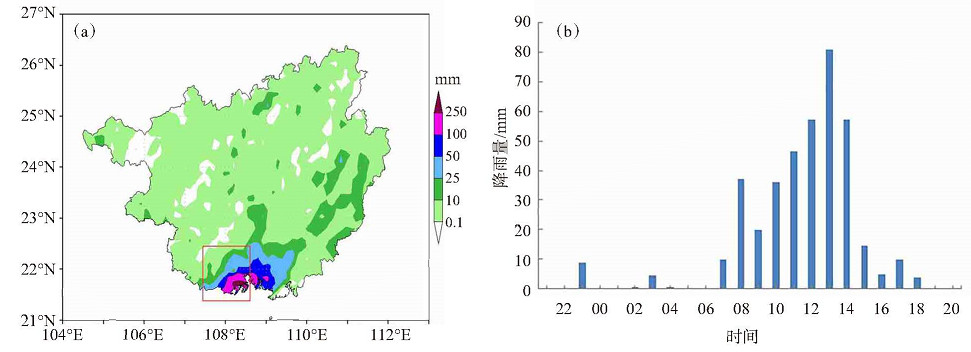DISCUSSION ON CAUSE AND MECHANISM OF TORRENTIAL RAIN ON JUNE 16, 2020 IN COASTAL AREAS OF FANGCHENGGANG IN GUANGXI ZHUANG AUTONOMOUS REGION
-
摘要: 利用NCEP FNL 1 °×1 °再分析、地面观测、FY-2G卫星和多普勒天气雷达等资料,对广西防城港沿海地区2020年6月16日出现的特大暴雨过程进行成因分析以及触发维持机制探讨。(1) 此次极端降雨过程是一次暖区暴雨过程,降雨过程主要分为两个阶段,具有局地性强,雨势猛,强度大,降水难预报和突发性等特点。(2) 暴雨在弱环流背景条件下发生,暴雨区有深厚的水汽和较强的不稳定能量,但天气尺度系统上升运动不深厚强度也不强,因而预报难度大。(3) 初始对流在防城港南部近海海面触发,靠近海岸线时迅速发展加强,在防城港沿海地区演变成一个较大尺度的MβCS,其西侧和南侧出现一连串强度45~55 dBZ γ中尺度对流系统,不断经过暴雨区上空,形成列车效应最终导致极端降雨的发生。(4) 天气尺度背景为北部湾近海海面出现对流提供了有利条件,低空急流的显著加强触发防城港市近海海面初始对流生成;不同性质下垫面的热力差异和MβCS冷池出流造成防城港沿海地区出现中尺度低压及中尺度辐合线,致使对流在防城港沿海地区增强和长时间维持。(5) 高温高湿环境中尺度扰动可能处于暖湿不稳定层结,微小的扰动也可以触发对流;预报服务中要利用多种新型高时空分辨率观测资料,及时判断分析沿海地区是否会出现海陆风或冷池出流等形成中尺度低压或辐合线。Abstract: Using the NCEP FNL 1 ° × 1 ° reanalysis data and the data from ground observation, FY2G satellite and doppler weather radar, the present study discussed the cause and the triggering and maintenance mechanism of the torrential rain occurred on June 16, 2020 in the coastal areas of Fangchenggang in Guangxi Zhuang Autonomous Region. The results show that: (1) The extreme rainfall process is a warm-sector heavy rainfall. The rainfall process can be divided into two stages and it features highly concentrated heavy rainfall, strong intensity, and sudden precipitation, rendering it difficult to predict. (2) The rainstorm occurred under the background of weak circulation. The rainstorm area had deep water vapor and strong unstable energy, but the ascending motion of synoptic scale system was not deep nor strong, so it was difficult to forecast. (3) The initial convection was triggered in the coastal sea surface to the southern part of Fangchenggang, developed rapidly near the coastline, and evolved into a large-scale MβCS in the coastal areas of Fangchenggang. A series of meso-γ scale convective systems with intensity of 45~55 dBZ appeared on the west and south sides of MβCS and they continuously passed through the heavy rain area, forming the train effect and eventually leading to extreme rainfall. (4) There were favorable conditions for convection in the offshore waters of Beibu Gulf. The significant strengthening of low-level jet triggered the initial convection in the offshore waters of Fangchenggang. Thermal difference of different underlying surfaces and MβCS cold pool outflow cause mesoscale low pressure and mesoscale convergence line in the coastal areas of Fangchenggang, resulting in convective enhancement and longterm maintenance. (5) Mesoscale systems in high temperature and high humidity environments may be in warm and humid unstable stratification, and small disturbances may trigger convection. A variety of new high spatial and temporal resolution observational data should be used in forecast service to help analyze whether there will be sea-land breeze or cold pool outflow in the coastal areas to form mesoscale low pressure or convergence line.
-
-
[1] 刘璐, 冉令坤, 周玉淑, 等. 北京"7.21"暴雨的不稳定性及其触发机制分析[J]. 大气科学, 2015, 39(3): 583-595. [2] 周玉淑, 刘璐, 朱科锋, 等. 北京"7.21"特大暴雨过程中尺度系统的模拟及演变特征分析[J]. 大气科学, 2014, 38(5): 885-896. [3] 陈炳洪, 林良勋, 张维, 等. 5·23广东特大暴雨过程特点及数值诊断分析[J]. 热带气象学报, 2011, 27(5): 738-744. [4] 曾智琳, 谌芸, 朱克云, 等. 2017年"5·7"广州特大暴雨的中尺度特征分析与成因初探[J]. 热带气象学报, 2018, 34(5): 791-805. [5] 汪海恒, 张曙, 伍志方, 等. 2019年韶关"5·18"局地特大暴雨极端性成因分析[J]. 热带气象学报, 2021, 37(1): 49-60. [6] 李昀英, 曹芳. 广西特大暴雨过程中两类中尺度系统的模式预报能力研究[J]. 热带气象学报, 2013, 29(1): 161-168. [7] 冉令坤, 李舒文, 周玉淑, 等. 2021年河南"7.20"极端暴雨动、热力和水汽特征观测分析[J]. 大气科学, 2021, 45(6): 1 366-1 383. [8] 苏爱芳, 吕晓娜, 崔丽曼, 等. 郑州"7.20"极端暴雨天气的基本观测分析[J]. 暴雨灾害, 2021, 40(5): 445-454. [9] 李菁, 卢伟萍, 姚才. 广西特大暴雨的特征分析[J]. 广西气象, 2002, 23(4): 9-12. [10] 练江帆, 梁必骐. 广东致洪特大暴雨的综合分析[J]. 热带气象学报, 1999, 15(3): 230-239. [11] 唐伟民, 刘汉华. "20070814"台州市特大暴雨过程诊断分析[J]. 浙江气象, 2010, 31(3): 1-5. [12] 冯小芳, 徐峰. 粤西沿海"4.20"特大暴雨特征分析[J]. 广东海洋大学学报, 2014, 34(3): 93-98. [13] 胡雅君, 张伟. "5.7"闽南沿海暖区特大暴雨中尺度特征分析[J]. 气象, 2020, 46(5): 629-642. [14] 胡雅君, 张伟, 赵玉春, 等. "5.7"闽南沿海暖区特大暴雨中尺度特征分析[J]. 气象, 2020, 46(5): 629-642. [15] 周武, 黄忠. 2008年6月5-7日阳江特大暴雨的中尺度特征[J]. 广东气象, 2010, 32(2): 14-17. [16] 周淑玲, 闫淑莲, 张灿. 2007年8月10-12日山东半岛持续性特大暴雨的维持机制分析[J]. 热带气象学报, 2009, 25(5): 628-634. [17] 蔡景就, 伍志方, 陈晓庆, 等. "18·8"广东季风低压持续性特大暴雨成因分析[J]. 暴雨灾害, 2019, 38(6): 576-586. [18] 叶朗明, 吴乃庚. 海陆风和地形对一次弱天气背景下暖区特大暴雨的影响分析[J]. 暴雨灾害, 2019, 38(6): 597-605. [19] 王坚红, 徐碧裕, 刘刚. 华南前汛期广东暴雨分区动力特征及特大暴雨分析[J]. 气象与环境学报, 2014, 30(6): 44-51. [20] 陈伟斌, 翟舒楠. 一次沿海局地特大暴雨的集合敏感性分析[J]. 气象研究与应用, 2019, 40(1): 11-15. [21] 余贞, 高守亭. 台风"海棠"特大暴雨数值模拟研究[J]. 气象学报, 2007, 65(6): 864-876. [22] 夏茹娣, 赵思雄. 一次华南锋前暖区暴雨β中尺度系统环境特征的分析研究[J]. 大气科学, 2006, 30(5): 988-1 008. [23] 孙继松, 王华, 王令, 等. 2006. 城市边界层过程在北京2004年7月10日局地暴雨过程中的作用[J]. 大气科学, 30(2): 221-224. [24] SROCK A F, BOSART L F. Heavy precipitation associated with southern appalachian cold-air damming and Carolina coastal frontogenesis in advance of weak landfalling tropical storm Marco(1990)[J]. Mon Wea Rev, 2009, 137(8): 2 448-2 470. -






 下载:
下载:








 粤公网安备 4401069904700003号
粤公网安备 4401069904700003号